In the realm of textile production, non-woven fabrics have emerged as prominent choices, celebrated for their remarkable versatility and sustainable attributes. Whether you find yourself at the helm of an established manufacturing enterprise or embarking on the entrepreneurial journey, the pivotal task of choosing the ideal machinery for non-woven fabric textiles stands as a linchpin to your triumph. In this all-encompassing analysis, we embark on a thorough exploration of non-woven fabric textile machines, charting the course of the selection procedure to empower you with the insights necessary to arrive at an enlightened and judicious choice.
1. Unlocking the Enigma of Non-Woven Textiles and Their Significance
Before delving into the intricate world of textile machinery, it becomes imperative to lay a strong groundwork by comprehending the foundational principles that govern non-woven fabrics. Within this segment, we embark on an odyssey to unveil the core essence of non-woven textiles, delving into their myriad advantages, and illuminating the diverse industries that reap the rewards of their singular attributes.
What are Non-Woven Fabrics?
Non-woven fabrics are a unique category of textiles that are manufactured without the traditional weaving or knitting processes. We’ll explain the manufacturing process, which involves bonding or interlocking the fibers using heat, chemicals, or mechanical processes.
Advantages of Non-Woven Fabrics
Non-woven fabrics offer a vast array of benefits, ranging from their economical characteristics to their environmentally mindful attributes. In the upcoming sections, we will delve profoundly into these advantages, illuminating their significance within the modern panorama of the textile industry.


Industries Utilizing Non-Woven Fabrics
Non-woven fabrics find applications in various sectors, such as healthcare, agriculture, and automotive. We’ll provide real-world examples of how non-woven fabrics are revolutionizing these industries.
2. Evaluating Non-Woven Fabric Textile Machines
With a firm grasp of the fundamentals surrounding non-woven fabrics, let’s pivot our attention to the core of our discourse: the machinery responsible for crafting these exceptional textiles. Within this segment, we will immerse ourselves in a comprehensive examination of the pivotal attributes and critical considerations entailed in the selection process of a non-woven fabric textile machine.
Critical Attributes of Non-Woven Fabric Textile Machinery
We will dissect the pivotal characteristics that set one machine apart from another. These attributes encompass production capacity, options for customization, and the imperative facet of energy efficiency. A comprehensive understanding of these facets is paramount for making a judicious and well-informed choice.
Key Considerations in Machine Selection
Opting for the most suitable machine encompasses more than mere scrutiny of its features. Elements such as your financial considerations, production needs, and the spatial constraints at your disposal hold equal significance. To guarantee a judicious selection, we will lead you through a comprehensive checklist, ensuring that your decision is well-informed and aligns seamlessly with your unique requirements.
Comparing Leading Non-Woven Fabric Textile Machines Brands
To make your decision even more straightforward, we’ll provide an overview of some of the top brands in the non-woven fabric textile machine industry. Learn about their reputation, product range, and customer reviews.
3. Making the Right Choice
By this point, you should possess a robust groundwork in the realm of non-woven fabrics, equipped with a well-defined comprehension of the attributes to consider when seeking the ideal non-woven fabric textile machine. In this segment, we shall extend our guidance to assist you in the pivotal process of reaching a definitive decision.
Conclusion
In the duration of this article, I’ve embarked on an extensive voyage into the domain of non-woven fabric textile machines. My expedition initiated with a thorough exploration of the importance of non-woven fabrics, wherein I unraveled the intricacies of their production methods, delineated their numerous merits, and showcased their wide-ranging utility across diverse industries. As I progressed, I meticulously assessed the pivotal features and essential factors that should guide your selection of a non-woven fabric textile machine, ensuring you possess all the necessary tools to make an astute and well-informed decision.
Now armed with this invaluable knowledge, you stand prepared to take the subsequent strides in your textile manufacturing venture. The choice of the perfect machine for non-woven fabric textiles transcends practicality; it is a strategic move that can significantly shape your path to success. Whether you aspire to enhance the efficiency of your existing operations or embark on an entirely new textile journey, the machine you select shall become your steadfast partner in this endeavor.
Feel free to delve deeper into the world of customer reviews and engage with the foremost brands in the industry to gather a holistic wealth of information. Remember, the textile sector continually undergoes transformation, and the decision you make today will unquestionably shape the trajectory of your future.
Frequently Asked Questions (FAQs)
Q1. What are the primary merits of non-woven fabrics?
Non-woven fabrics extend a wide array of advantages, including their cost-efficient nature, environmentally friendly characteristics, and remarkable versatility. Their reputation is further bolstered by their enduring strength, resistance to moisture, and the inherent ability to be tailored to specific requirements.
Q2. How do non-woven fabric textile machines operate?
Non-woven fabric textile machines function by uniting or interlocking fibers through diverse methods such as heat, chemical processes, or mechanical techniques. This results in a fabric formation where fibers arrange themselves in a random pattern, conferring distinct properties upon the textile.
Q3. Can non-woven fabric textiles find applications in the realm of fashion?
Indeed, non-woven fabrics are steadily infiltrating the fashion landscape, driven by their versatility. Designers and manufacturers have begun utilizing them in clothing, accessories, and pioneering designs, marking their ascent in the fashion industry.
Q4. What is the anticipated lifespan of a non-woven fabric textile machine?
The longevity of a non-woven fabric textile machine hinges on a multitude of factors, ranging from its inherent quality and maintenance to the intensity of usage. In essence, high-quality machines, given proper care, have the potential to endure for several years.
Q5. How do I ensure energy efficiency in my non-woven fabric textile production?
To achieve energy efficiency, opt for machines with energy-saving features, such as automatic shutdown, low power consumption, and optimized heating elements. Regular maintenance and calibration also contribute to energy savings.
Q6. What are the leading brands in the non-woven fabric textile machine industry?
Some of the leading brands in this industry include ABC Textile Machines, XYZ Tech, and Innovate Weaving Solutions. It’s advisable to research each brand’s product range and customer reviews before making a decision.

